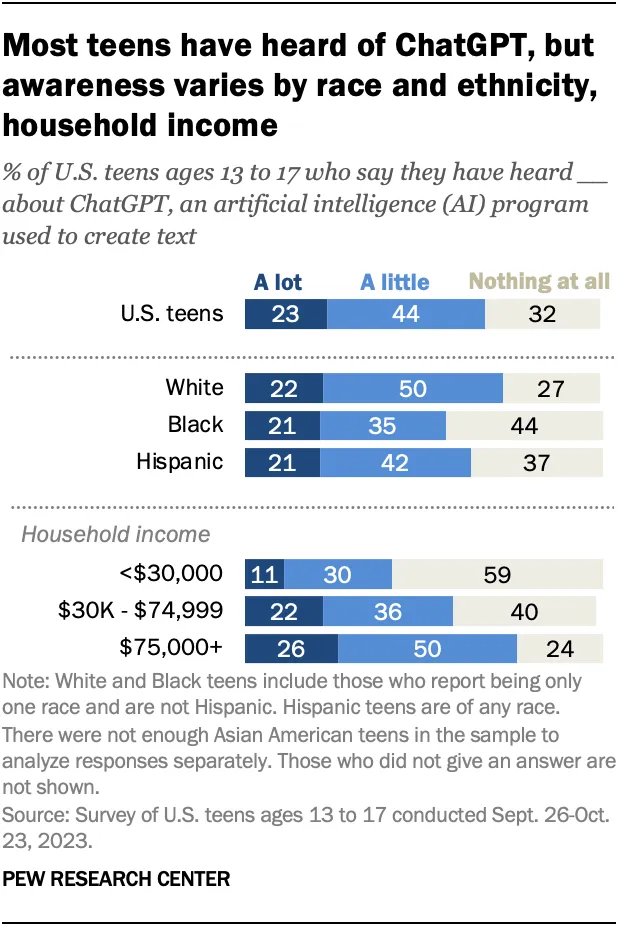ChatGPT has created monumental changes in the manner in which work ends up being done, but no change has been more pertinent than that of school work. It turns out that 19% of US students that are familiar with ChatGPT have already started using it to get work done for school. Since most of these teenage students have heard of ChatGPT, this amounts to 13% of Americans between the ages of 13 and 17 with all things having been considered and taken into account.
This comes from a recent survey conducted by the Pew Research Center, and it sheds some light on the state of affairs today. With all of that having been said and now out of the way, it is important to note that older children are disproportionately likely to use the Large Language Model for the purposes of completing tasks for school. 24% of children who are in grades 11 and 12 use ChatGPT, 17% of those in grades 9 or 10 said the same, and 12% in grades 7 and 8 stated that they use it.
One thing that bears mentioning is that boys are more likely to use ChatGPT than might have been the case otherwise. 21% of boys acknowledged their reliance on the Large Language Model, whereas just 17% of girls said the same. There is also a bit of a racial disparity, with 72% of Caucasian teens saying they’ve heard of ChatGPT, compared to 63% of Hispanic students and 56% of African Americans.
Unsurprisingly, higher household incomes also contribute to a more widespread usage of ChatGPT because of the fact that this is the sort of thing that could potentially end up making the tech more accessible. 3 out of 4 children who were raised in households where incomes exceeded $75,000 admitted that they’re aware of ChatGPT and all that it can accomplish. By comparison, 58% of teens hailing from households with incomes ranging from $30,000 to $74,999 said the same, and the proportion was just 41% who lived in homes where the income was below $30,000.
69% of teens said that using ChatGPT for research is perfectly acceptable, although just 20% would go so far as to use it to completely write out their essays. Solving math problems is more divisive, with 39% saying its fair and 36% disagreeing with this sentiment.
Read next: From Language Models to AGI: Google DeepMind's Journey in Redefining AI's Future
This comes from a recent survey conducted by the Pew Research Center, and it sheds some light on the state of affairs today. With all of that having been said and now out of the way, it is important to note that older children are disproportionately likely to use the Large Language Model for the purposes of completing tasks for school. 24% of children who are in grades 11 and 12 use ChatGPT, 17% of those in grades 9 or 10 said the same, and 12% in grades 7 and 8 stated that they use it.
One thing that bears mentioning is that boys are more likely to use ChatGPT than might have been the case otherwise. 21% of boys acknowledged their reliance on the Large Language Model, whereas just 17% of girls said the same. There is also a bit of a racial disparity, with 72% of Caucasian teens saying they’ve heard of ChatGPT, compared to 63% of Hispanic students and 56% of African Americans.
Unsurprisingly, higher household incomes also contribute to a more widespread usage of ChatGPT because of the fact that this is the sort of thing that could potentially end up making the tech more accessible. 3 out of 4 children who were raised in households where incomes exceeded $75,000 admitted that they’re aware of ChatGPT and all that it can accomplish. By comparison, 58% of teens hailing from households with incomes ranging from $30,000 to $74,999 said the same, and the proportion was just 41% who lived in homes where the income was below $30,000.
69% of teens said that using ChatGPT for research is perfectly acceptable, although just 20% would go so far as to use it to completely write out their essays. Solving math problems is more divisive, with 39% saying its fair and 36% disagreeing with this sentiment.
Read next: From Language Models to AGI: Google DeepMind's Journey in Redefining AI's Future



